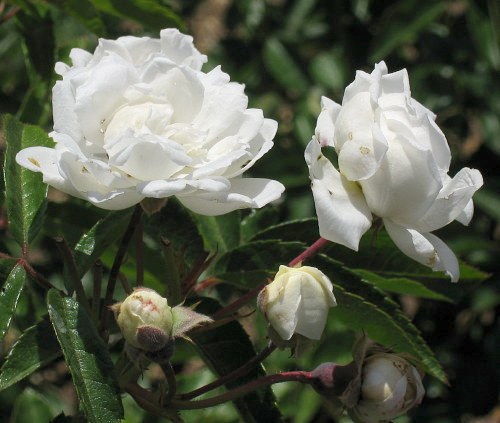Both the R. setigera and R. maximowicziana clones I know are fairly disease-prone here in the Mid-Atlantic; they sometimes give the appearance of health if they manage to keep growing later into the season, but the older and lower foliage becomes diseased. The plants are otherwise rampant enough to outgrow most serious problems. R. maximowicziana builds up over time to several feet.
I tried two clones of R. setigera in Minnesota in northern zone 4a (a thorny one from a source I can’t remember, and the pistillate Serena Group clone from Vintage Gardens), and neither was very cold-hardy–the latter was the more tender of the two. I also tried the R. maximowicziana hybrid ‘White Mountains’ there, but it was nowhere near hardy enough to grow as a climber. It is another one that is fairly disease prone but continues growing during the season, so it gives the outward appearance of being reasonably healthy from a distance.
Here, I have a seedling of ‘Baltimore Belle’ pollinated by ‘White Mountains’ that is an absolute beast of a rose (thick, stiff, long stems that eventually arch outward and are covered in massive prickles) but is utterly stunning in bloom. It doesn’t exactly have better foliar disease resistance than the parents, but the foliage is thick, dark green and robust. What it lacks in foliar disease resistance is more than made up for by its canes, which seem to be immune to any problems with disease or borers, which is interesting.
I also have a couple of seedlings of the Serena Group clone of R. setigera pollinated by R. luciae ‘Basye’s Thornless’. One has some prickles in random, odd patches on the stems, and many prickles under the leaves; the other is nearly completely without prickles on the stems but still has numerous very small and grabby leaf rachis prickles. The latter plant is about the closest imaginable thing to a rose analog of kudzu with its very thin and fast-growing stems. It blooms only sparsely with single, light pink flowers, and I think sets hips even more rarely than that (i.e., I’m not sure if I’ve seen hips on it or if my eyes were playing tricks on me). However, I don’t know if I’ve seen a speck of disease on it.
I had originally thought that the R. setigera Serena Group did not pass along thornlessness based on early results from a cross with ‘Darlow’s Enigma’, but one vigorous seedling seems to be prickly only on the lower half of its basal shoots, then becomes sparsely prickled to almost smooth above that. Another seedling that is less vigorous seems to be relatively smooth overall, but hasn’t gotten very large yet and is still in a fairly small container for its own good. They don’t seem to have inherited especially good foliar disease resistance from the pollen parent, either, but both have very healthy stems. Of course, ‘Darlow’s Enigma’ sometimes has imperfect disease resistance here, too.
If one could start by crossing R. maximowicziana with R. luciae and then backcross healthy seedlings to the seed parent species for a generation or two more, and then cross the healthiest and hardiest products with the healthiest and hardiest forms of R. setigera (which may not be Serena Group, as that hails from southern Missouri), you might have something to work with as a partial base for healthy, hardier ramblers/climbers. I also think that there is a role for Sect. Rosa in the mix to provide the extra cold-hardiness needed, considering R. x paulii, ‘Ames Climber’, and ‘Max Graf’ (and of course “R. x kordesii”).
Stefan
